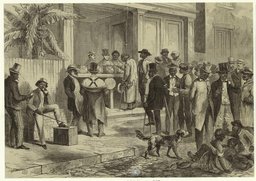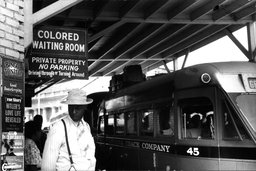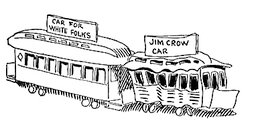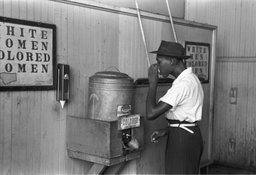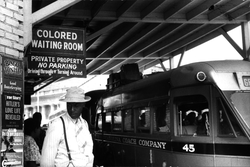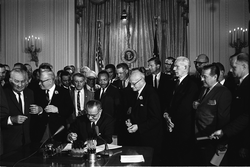Jim Crow laws
Jim Crow laws
Jim Crow lawswere state and local laws that enforced racial segregation in the Southern United States.
Enacted by white Democratic-dominated state legislatures in the late 19th century after the Reconstruction period, these laws continued to be enforced until 1965.
They mandated racial segregation in all public facilities in the states of the former Confederate States of America, starting in 1896 with a " separate but equal " status for African Americans in railroad cars.
Public education had essentially been segregated since its establishment in most of the South after the Civil War.
This principle was extended to public facilities and transportation, including segregated cars on interstate trains and, later, buses.
Facilities for African Americans were consistently inferior and underfunded compared to those which were then available to European Americans; sometimes they did not exist at all.
This body of law institutionalized a number of economic, educational, and social disadvantages.
Segregation by law existed mainly in the Southern states, while Northern segregation was generally a matter of fact —patterns of housing segregation enforced by private covenants, bank lending practices, and job discrimination, including discriminatory labor union practices.
"Jim Crow" was a pejorative expression meaning "Negro".
Jim Crow laws—sometimes, as in Florida, part of state constitutions—mandated the segregation of public schools, public places, and public transportation, and the segregation of restrooms, restaurants, and drinking fountains for whites and blacks.
The U.S. military was already segregated.
President Woodrow Wilson, a Southerner, initiated segregation of federal workplaces at the request of southern Cabinet members in 1913.
These Jim Crow laws revived principles of the 1865 and 1866 Black Codes, which had previously restricted the civil rights and civil liberties of African Americans.
Segregation of public (state-sponsored) schools was declared unconstitutional by the Supreme Court of the United States in 1954 inBrown v. Board of Education.
In some states it took years to implement this decision.
Generally, the remaining Jim Crow laws were overruled by the Civil Rights Act of 1964 and the Voting Rights Act of 1965, but years of action and court challenges have been needed to unravel the many means of institutional discrimination.
Etymology
The phrase "Jim Crow Law" can be found as early as 1892 in the title of a* New York Times* article about Louisiana requiring segregated railroad cars.
The origin of the phrase "Jim Crow" has often been attributed to " Jump Jim Crow ", a song-and-dance caricature of blacks performed by white actor Thomas D. Rice in blackface, which first surfaced in 1832 and was used to satirize Andrew Jackson 's populist policies.
As a result of Rice's fame, "Jim Crow" by 1838 had become a pejorative expression meaning "Negro".
When southern legislatures passed laws of racial segregation directed against blacks at the end of the 19th century, these statutes became known as Jim Crow laws.
Origins of Jim Crow laws
During the Reconstruction period of 1865–1877, federal laws provided civil rights protections in the U.S. South for freedmen, the African Americans who had formerly been slaves, and the minority of blacks who had been free before the war.
In the 1870s, Democrats gradually regained power in the Southern legislatures, having used insurgent paramilitary groups, such as the White League and the Red Shirts, to disrupt Republican organizing, run Republican officeholders out of town, and intimidate blacks to suppress their voting.
Extensive voter fraud was also used.
Gubernatorial elections were close and had been disputed in Louisiana for years, with increasing violence against blacks during campaigns from 1868 onward.
In 1877, a national Democratic Party compromise to gain Southern support in the presidential election resulted in the government's withdrawing the last of the federal troops from the South.
White Democrats had regained political power in every Southern state.
These Southern, white, Democratic Redeemer governments legislated Jim Crow laws, officially segregating black people from the white population.
Blacks were still elected to local offices throughout the 1880s, but their voting was suppressed for state and national elections.
Democrats passed laws to make voter registration and electoral rules more restrictive, with the result that political participation by most blacks and many poor whites began to decrease.
Between 1890 and 1910, ten of the eleven former Confederate states, starting with Mississippi, passed new constitutions or amendments that effectively disenfranchised most blacks and tens of thousands of poor whites through a combination of poll taxes, literacy and comprehension tests, and residency and record-keeping requirements.
Grandfather clauses temporarily permitted some illiterate whites to vote but gave no relief to most blacks.
Voter turnout dropped drastically through the South as a result of such measures.
In Louisiana, by 1900, black voters were reduced to 5,320 on the rolls, although they comprised the majority of the state's population.
By 1910, only 730 blacks were registered, less than 0.5% of eligible black men.
"In 27 of the state's 60 parishes, not a single black voter was registered any longer; in 9 more parishes, only one black voter was." [undefined] The cumulative effect in North Carolina meant that black voters were completely eliminated from voter rolls during the period from 1896–1904.
The growth of their thriving middle class was slowed.
In North Carolina and other Southern states, blacks suffered from being made invisible in the political system: "[W]ithin a decade of disfranchisement, the white supremacy campaign had erased the image of the black middle class from the minds of white North Carolinians." [undefined] In Alabama tens of thousands of poor whites were also disenfranchised, although initially legislators had promised them they would not be affected adversely by the new restrictions.
Those who could not vote were not eligible to serve on juries and could not run for local offices.
They effectively disappeared from political life, as they could not influence the state legislatures, and their interests were overlooked.
While public schools had been established by Reconstruction legislatures for the first time in most Southern states, those for black children were consistently underfunded compared to schools for white children, even when considered within the strained finances of the postwar South where the decreasing price of cotton kept the agricultural economy at a low.
Like schools, public libraries for blacks were underfunded, if they existed at all, and they were often stocked with secondhand books and other resources.
These facilities were not introduced for African Americans in the South until the first decade of the 20th century.
Throughout the Jim Crow era, libraries were only available sporadically.
Prior to the 20th century, most libraries established for African Americans were school-library combinations.
Many public libraries for both European-American and African American patrons in this period were founded as the result of middle-class activism aided by matching grants from the Carnegie Foundation.
In some cases, progressive measures intended to reduce election fraud, such as the Eight Box Law in South Carolina, acted against black and white voters who were illiterate, as they could not follow the directions.
While the separation of African Americans from the general population was becoming legalized and formalized during the Progressive Era (1890s–1920s), it was also becoming customary.
For instance, even in cases in which Jim Crow laws did not expressly forbid black people to participate in sports or recreation, a segregated culture had become common.
In the Jim Crow context, the presidential election of 1912 was steeply slanted against the interests of black Americans.
Most blacks still lived in the South, where they had been effectively disfranchised, so they could not vote at all.
While poll taxes and literacy requirements banned many poor or illiterate Americans from voting, these stipulations frequently had loopholes that exempted European Americans from meeting the requirements.
In Oklahoma, for instance, anyone qualified to vote before 1866, or related to someone qualified to vote before 1866 (a kind of " grandfather clause "), was exempted from the literacy requirement** ;** but the only persons who had the franchise before that year were white, or European-American males.
European Americans were effectively exempted from the literacy testing, whereas black Americans were effectively singled out by the law.
Woodrow Wilson was a Democrat elected from New Jersey, but he was born and raised in the South, and was the first Southern-born president of the post- Civil War period.
He appointed Southerners to his Cabinet.
Some quickly began to press for segregated workplaces, although the city of Washington, D.C., and federal offices had been integrated since after the Civil War.
In 1913, for instance, Secretary of the Treasury William Gibbs McAdoo – an appointee of the President – was heard to express his opinion of black and white women working together in one government office: "I feel sure that this must go against the grain of the white women.
Is there any reason why the white women should not have only white women working across from them on the machines?"
Wilson introduced segregation in federal offices, despite much protest from African-American leaders and national groups.
He appointed segregationist Southern politicians because of his own firm belief that racial segregation was in the best interest of black and European Americans alike.
At Gettysburg on July 4, 1913, the semi-centennial of Abraham Lincoln 's declaration that " all men are created equal ", Wilson addressed the crowd:
In sharp contrast to Wilson, aWashington Bee editorial wondered if the "reunion" of 1913 was a reunion of those who fought for "the extinction of slavery" or a reunion of those who fought to "perpetuate slavery and who are now employing every artifice and argument known to deceit" to present emancipation as a failed venture.
Historian David W. Blight notes that the "Peace Jubilee" at which Wilson presided at Gettysburg in 1913 "was a Jim Crow reunion, and white supremacy might be said to have been the silent, invisible master of ceremonies." (Great Reunion of 1913
In Texas, several towns adopted residential segregation laws between 1910 and the 1920s.
Legal strictures called for segregated water fountains and restrooms.
Jim Crow laws were a product of what had become the solidly Democratic South due to disfranchisement of blacks.
Early attempts to break Jim Crow
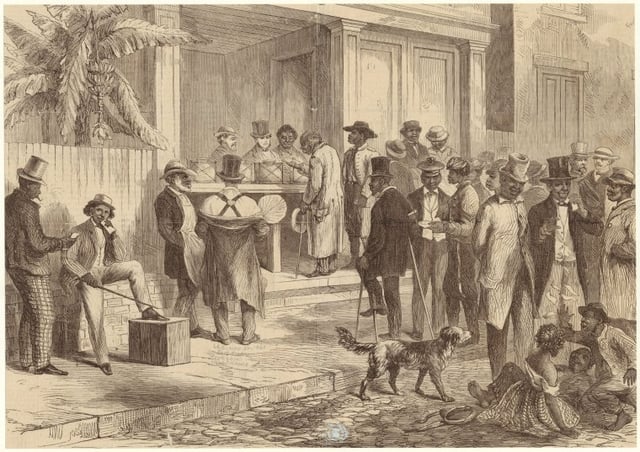
Freedmen voting in New Orleans, 1867
The Civil Rights Act of 1875, introduced by Charles Sumner and Benjamin F. Butler, stipulated a guarantee that everyone, regardless of race, color, or previous condition of servitude, was entitled to the same treatment in public accommodations, such as inns, public transportation, theaters, and other places of recreation.
This Act had little effect.
An 1883 Supreme Court decision ruled that the act was unconstitutional in some respects, saying Congress was not afforded control over private persons or corporations.
With white southern Democrats forming a solid voting bloc in Congress, due to having outsize power from keeping seats apportioned for the total population in the South (although hundreds of thousands had been disenfranchised), Congress did not pass another civil rights law until 1957.
In 1887, Rev. W. H. Heard lodged a complaint with the Interstate Commerce Commission against the Georgia Railroad company for discrimination, citing its provision of different cars for white and black/colored passengers.
The company successfully appealed for relief on the grounds it offered "separate but equal" accommodation.
In 1890, Louisiana passed a law requiring separate accommodations for colored and white passengers on railroads.
Louisiana law distinguished between "white", "black" and "colored" (that is, people of mixed European and African ancestry).
The law had already specified that blacks could not ride with white people, but colored people could ride with whites before 1890.
A group of concerned black, colored and white citizens in New Orleans formed an association dedicated to rescinding the law.
The group persuaded Homer Plessy to test it; he was a man of color who was of fair complexion and one-eighth "Negro" in ancestry.
In 1892, Plessy bought a first-class ticket from New Orleans on the East Louisiana Railway.
Once he had boarded the train, he informed the train conductor of his racial lineage and took a seat in the whites-only car.
He was directed to leave that car and sit instead in the "coloreds only" car.
Plessy refused and was immediately arrested.
The Citizens Committee of New Orleans fought the case all the way to the United States Supreme Court.
They lost inPlessy v. Ferguson
In 1908 Congress defeated an attempt to introduce segregated streetcars into the capital.
Racism in the United States and defenses of Jim Crow
White Southerners encountered problems in learning free labor management after the end of slavery, and they resented black Americans, who represented the Confederacy 's Civil War defeat: "With white supremacy being challenged throughout the South, many whites sought to protect their former status by threatening African Americans who exercised their new rights." White Democrats used their power to segregate public spaces and facilities in law and reestablish social dominance over blacks in the South.
One rationale for the systematic exclusion of black Americans from southern public society was that it was for their own protection.
An early 20th-century scholar suggested that allowing blacks to attend white schools would mean "constantly subjecting them to adverse feeling and opinion", which might lead to "a morbid race consciousness".
This perspective took anti-black sentiment for granted, because bigotry was widespread in the South after slavery became a racial caste system.
Post-World War II era
After World War II, African Americans increasingly challenged segregation, as they believed they had more than earned the right to be treated as full citizens because of their military service and sacrifices.
The Civil Rights Movement was energized by a number of flashpoints, including the 1946 police beating and blinding of World War II veteran Isaac Woodard while he was in U.S.
Army uniform.
In 1948 President Harry S. Truman issued Executive Order 9981, desegregating the armed services.
As the Civil Rights Movement gained momentum and used federal courts to attack Jim Crow statutes, the European-dominated governments of many of the southern states countered by passing alternative forms of restrictions.
The NAACP Legal Defense Committee (a group that became independent of the NAACP) – and its lawyer, Thurgood Marshall – brought the landmark caseBrown v. Board of Education of Topeka, 347 U.S. (1954) before the Supreme Court.
In its pivotal 1954 decision, the Court unanimously overturned the 1896* Plessy* decision.
The Supreme Court found that legally mandated (de jure
History has shown that problems of educating poor children are not confined to minority status, and states and cities have continued to grapple with approaches.
The court ruling did not stop* de facto* or residentially based school segregation.
Such segregation continues today in many regions.
Some city school systems have also begun to focus on issues of economic and class segregation rather than racial segregation, as they have found that problems are more prevalent when the children of the poor of any ethnic group are concentrated.
Associate JusticeFrank Murphy introduced the word "racism" into the lexicon of U.S.
Supreme Court opinions inKorematsu v. United States, 323 U.S. 214 (1944).
He stated that by upholding the forced relocation of Japanese Americans during World War II, the Court was sinking into "the ugly abyss of racism".
This was the first time that "racism" was used in Supreme Court opinion (Murphy used it twice in a concurring opinion inSteele v Louisville & Nashville Railway Co 323 192 (1944) issued that day).
Murphy used the word in five separate opinions, but after he left the court, "racism" was not used again in an opinion for almost two decades.
It next appeared in the landmark decision ofLoving v. Virginia, 388 U.S. (1967).
Interpretation of the Constitution and its application to minority rights continues to be controversial as Court membership changes.
Observers such as Ian F.
Lopez believe that in the 2000s, the Supreme Court has become more protective of the status quo.
Removal
Courts
In 1971, the Supreme Court, inSwann v. Charlotte-Mecklenburg Board of Education, upheld desegregation busing of students to achieve integration.
Public arena
In 1955, Rosa Parks refused to give up her seat on a city bus to a white man in Montgomery, Alabama.
This act of civil disobedience was an important catalyst in the growth of the Civil Rights Movement; activists built the Montgomery Bus Boycott around it, which lasted more than a year and resulted in desegregation of the privately run buses in the city.
Civil rights protests and actions, together with legal challenges, resulted in a series of legislative and court decisions which contributed to undermining the Jim Crow system.
Numerous boycotts and demonstrations against segregation had occurred throughout the 1930s and 1940s.
The NAACP had been engaged in a series of litigation cases since the early 20th century in efforts to combat laws that disenfranchised black voters across the South.
Some of the early demonstrations achieved positive results, strengthening political activism, especially in the post-World War II years.
Black veterans were impatient with social oppression after having fought for the United States and freedom across the world.
In 1947 K. Leroy Irvis of Pittsburgh 's Urban League, for instance, led a demonstration against employment discrimination by the city's department stores.
It was the beginning of his own influential political career.
End of de jure segregation
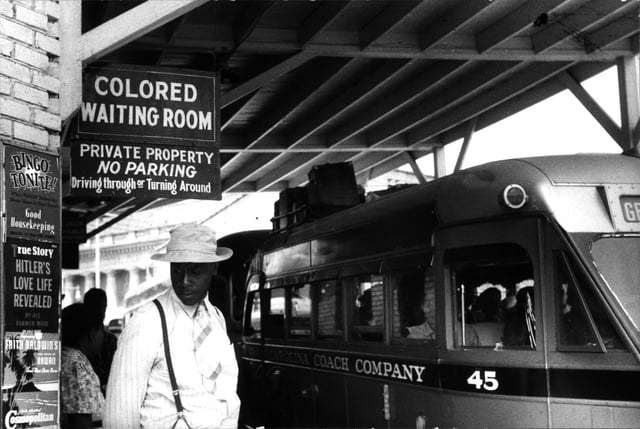
Sign for the "colored" waiting room at a bus station in Durham, North Carolina, 1940
In January 1964, President Lyndon Johnson met with civil rights leaders.
On January 8, during his first State of the Union address, Johnson asked Congress to "let this session of Congress be known as the session which did more for civil rights than the last hundred sessions combined." On June 21, civil rights workers Michael Schwerner, Andrew Goodman, and James Chaney disappeared in Neshoba County, Mississippi, where they were volunteering in the registration of African-American voters as part of the Mississippi Summer Project.
The disappearance of the three activists captured national attention and the ensuing outrage was used by Johnson and civil rights activists to build a coalition of northern Democrats and Republicans and push Congress to pass the Civil Rights Act of 1964.
On July 2, 1964, Johnson signed the historic Civil Rights Act of 1964.
[undefined] It invoked the Commerce Clause [undefined] to outlaw discrimination in public accommodations (privately owned restaurants, hotels, and stores, and in private schools and workplaces).
This use of the Commerce Clause was upheld inHeart of Atlanta Motel v. United States
By 1965, efforts to break the grip of state disenfranchisement by education for voter registration in southern counties had been under way for some time, but had achieved only modest success overall.
In some areas of the Deep South, white resistance made these efforts almost entirely ineffectual.
The murder of the three voting-rights activists in Mississippi in 1964 and the state's refusal to prosecute the murderers, along with numerous other acts of violence and terrorism against blacks, had gained national attention.
Finally, the unprovoked attack on March 7, 1965, by county and state troopers on peaceful Alabama marchers crossing the Edmund Pettus Bridge en route from Selma to the state capital of Montgomery, persuaded the President and Congress to overcome Southern legislators' resistance to effective voting rights enforcement legislation.
President Johnson issued a call for a strong voting rights law and hearings soon began on the bill that would become the Voting Rights Act.
The Voting Rights Act of 1965 ended legally sanctioned state barriers to voting for all federal, state and local elections.
It also provided for federal oversight and monitoring of counties with historically low minority voter turnout.
Years of enforcement have been needed to overcome resistance, and additional legal challenges have been made in the courts to ensure the ability of voters to elect candidates of their choice.
For instance, many cities and counties introduced at-large election of council members, which resulted in many cases of diluting minority votes and preventing election of minority-supported candidates.
Although sometimes counted among "Jim Crow laws" of the South, such statutes as anti-miscegenation laws were also passed by other states.
Anti-miscegenation laws were not repealed by the Civil Rights Act of 1964 [undefined] but were declared unconstitutional by the 1967 Supreme Court ruling inLoving v. Virginia
African-American life
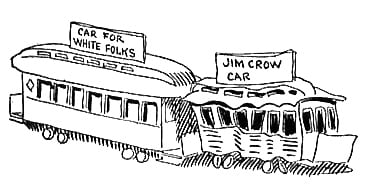
1904 caricature of "White" and "Jim Crow" rail cars by John T. McCutcheon.
The Jim Crow laws and the high rate of lynchings in the South were major factors which led to the Great Migration during the first half of the 20th century.
Because opportunities were so limited in the South, African Americans moved in great numbers to northern cities to seek better lives, becoming an urbanized population.
Despite the hardship and prejudice of the Jim Crow era, several black entertainers and literary figures gained broad popularity with white audiences in the early 20th century.
They included luminaries such as tap dancers Bill "Bojangles" Robinson and the Nicholas Brothers, jazz musicians such as Louis Armstrong, Duke Ellington and Count Basie, and the actress Hattie McDaniel (in 1939 she was the first black to receive an Academy Award when she won the Best Supporting Actress Oscar for her performance as Mammy inGone with the Wind
African-American athletes faced much discrimination during the Jim Crow period.
White opposition led to their exclusion from most organized sporting competitions.
The boxers Jack Johnson and Joe Louis (both of whom became world heavyweight boxing champions ) and track and field athlete Jesse Owens (who won four gold medals at the 1936 Summer Olympics in Berlin) earned fame during this era.
In baseball, a color line instituted in the 1880s had informally barred blacks from playing in the major leagues, leading to the development of the Negro Leagues, which featured many fine players.
A major breakthrough occurred in 1947, when Jackie Robinson was hired as the first African American to play in Major League Baseball; he permanently broke the color bar.
Baseball teams continued to integrate in the following years, leading to the full participation of black baseball players in the Major Leagues in the 1960s.
Remembrance
Ferris State University in Big Rapids, Michigan, houses the Jim Crow Museum of Racist Memorabilia, an extensive collection of everyday items that promoted racial segregation or presented racial stereotypes of African Americans, for the purpose of academic research and education about their cultural influence.
New Jim Crow
In 2012, civil rights advocate Michelle Alexander argued inThe New Jim Crow that America's War on Drugs, which disproportionately affected African-Americans, had produced discrimination comparable to that of the Jim Crow laws.
Yale law professor James Forman Jr.
countered that African-Americans, as represented by such cities as Washington D.C., have generally supported tough-on-crime policies, and that there appears to be a connection between drugs and violent crimes.
See also
Anti-miscegenation laws
Black Codes in the United States
Burmese nationality law
Disenfranchisement after the Reconstruction era
Dunning School
Group Areas Act
List of Jim Crow law examples by state
Mass racial violence in the United States
Penal labour
Racism in the United States
Second-class citizen
Sundown town
Timeline of the African-American Civil Rights Movement
The New Jim Crow
